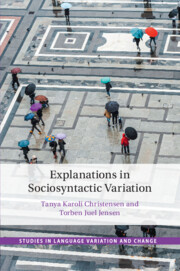Book contents
- Explanations in Sociosyntactic Variation
- Studies in Language Variation and Change
- Explanations in Sociosyntactic Variation
- Copyright page
- Contents
- Figures
- Tables
- Contributors
- Series Editor’s Preface
- Acknowledgements
- Introduction: Analysing and Explaining Syntactic Variation
- 1 Comparing Syntactic Variables
- 2 Mapping Syntax and the Sociolinguistic Monitor
- 3 A Columbia School Perspective on Explanation in Morphosyntactic Variation
- 4 On the Inevitability of Social Meaning and Ideology in Accounts of Syntactic Change: Evidence from Pronoun Competition in Netherlandic Dutch
- 5 The Predictability of Social Stratification of Syntactic Variants
- 6 When Variants Lack Semantic Equivalence: Adverbial Subclause Word Order
- Index
- References
1 - Comparing Syntactic Variables
Published online by Cambridge University Press: 06 January 2022
- Explanations in Sociosyntactic Variation
- Studies in Language Variation and Change
- Explanations in Sociosyntactic Variation
- Copyright page
- Contents
- Figures
- Tables
- Contributors
- Series Editor’s Preface
- Acknowledgements
- Introduction: Analysing and Explaining Syntactic Variation
- 1 Comparing Syntactic Variables
- 2 Mapping Syntax and the Sociolinguistic Monitor
- 3 A Columbia School Perspective on Explanation in Morphosyntactic Variation
- 4 On the Inevitability of Social Meaning and Ideology in Accounts of Syntactic Change: Evidence from Pronoun Competition in Netherlandic Dutch
- 5 The Predictability of Social Stratification of Syntactic Variants
- 6 When Variants Lack Semantic Equivalence: Adverbial Subclause Word Order
- Index
- References
Summary
This chapter deconstructs and compares two English syntactic variables as case studies to explore the linguistic/social interface in variation. The two variables are: (1) complementizer alternation (that/Ø) and (2) subject relative pronoun alternation (who/that/Ø). While both are internally and externally conditioned, the nature and strength of the predictors (also known as factors) differ significantly. I argue that the results from quantitative linguistic analysis, statistical modelling and a comparative perspective grounded in social and historical context provide unique insight into the synergy of social, cognitive, stylistic and linguistic factors. In the case of complementizers, the overwhelming influence of verb is the linguistic footprint that a particular collocation (e.g. I think) has grammaticalized into an epistemic parenthetical away from the original matrix plus complement construction. In the case of relative pronouns, the preponderance of who for subject, animate antecedents aligns with a well-known typological pattern (i.e. human animates contrast with non-humans), which is overlain with social evaluation originating from its prestigious origins that endures in current usage in the speech community. In sum, interpreting the varying roles played by multiplex influences on linguistics features is key to understanding variation.
Keywords
- Type
- Chapter
- Information
- Explanations in Sociosyntactic Variation , pp. 30 - 57Publisher: Cambridge University PressPrint publication year: 2022

